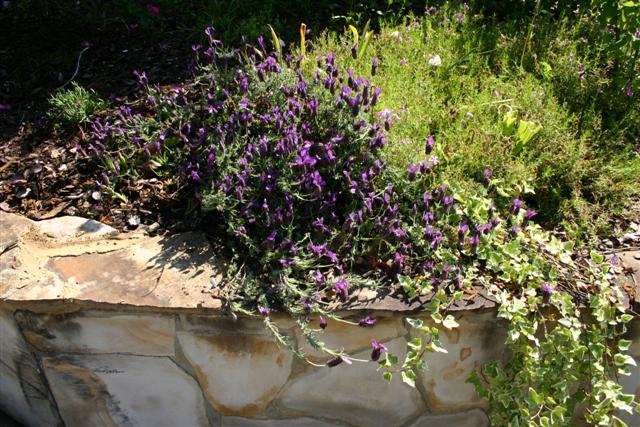Georgia Gardener Newsletter Design Tip: February 7, 2008
Blooming lavender draping over a wall
Herbs as Ornamentals
Other than a few tomatoes and peppers, I usually don't grow much food in my garden. I wish I did but a lack of time to tend
to these plants has always kept me from expanding my edible garden. However, there are quite a few "ornamental" plants that
have exquisite beauty in the garden, including and especially herbs.
The cultivation of herbs goes back to the earliest of human civilizations. Herbs have been and are grown as additives to food and
for their medicinal qualities. Although I grow a substantial number of medicinal and edible herbs, I do not harvest them for
use rather opting to leave them in the garden and enjoy them for their ornamental qualities.
Keep in mind that just like other plants, there will be herbs that are annuals, biennials and perennials. There will
also be herbs that are classified as herbaceous plants, shrubs and even trees. Annual herbs only last
one growing season, biennials will last two years and perennials will persist for several years in favorable conditions.
Growing Conditions
When it comes to the cultivation of most herbs, in addition to full sun there are three other key factors: drainage, drainage
and drainage. Many herbs (not all) originate from drier climates where the summers can be hot and the soil
has better drainage. I've lost a number of herbs in my garden because I didn't properly prepare the soil. Of course, we
have quite a few native herbs that fair much better in our soil and climate.
To grow some of the more popular herbs such as rosemary, thyme, sage, etc., you will need to add materials to the soil to
help increase the drainage, namely coarse sand or even crushed granite. You might find it easier to simply grow these plants
in raised beds. Most herbs are extremely drought tolerant and make excellent additions to your garden while we are experiencing
our current severe drought. Additionally, most herbs will be shunned by deer and rabbits.
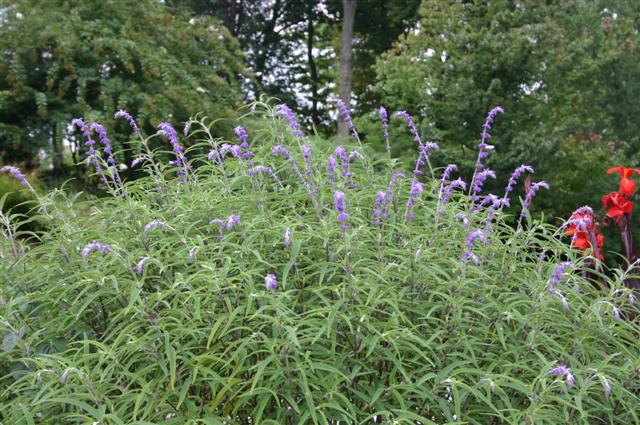
|
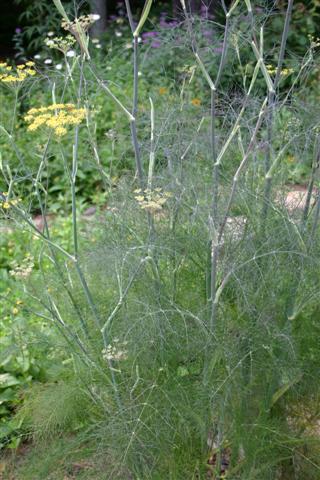
|
| Mexican Sage | Bronze Fennel |
Mexican Sage (Salvia leucantha) is a tender perennial that can reach 5 feet tall and wide. It blooms with purple on
white flowers in the late summer to fall and is attractive to butterflies, bees and hummingbirds. Make sure that it receives
full sun and sharp drainage. It's hardy to about 10 degrees. Note: The genus Salvia is amongst the largest group of
herbs with as many as 900 different species. The Mexican sage in my garden is now approaching 5 years of age having weathered
temperatures into the teens without protection.
Bronze fennel (Foeniculum vulgare) is slightly more hardy than the green varieties. With its bronze-tinged foliage
and yellow flowers, it can reach a height up to six feet tall. This plant is a host for the swallow tail butterfly and is
often covered with caterpillars in the summer. Watch this plant for unwanted seedlings. My bronze fennel only lasted
about two years before being killed by 15 degree winter temperatures. Although I think an abundance of winter moisture around
the stem contributed to its demise.
Other ornamental herbs include: Pineapple Sage (Salvia elegans), Mint (Mentha spp.), Agastache/Hyssop (Agastache spp.),
Rosemary (Rosmarinus spp.) and Thyme (Thymus spp) to name a few. Watch out! Some ornamental herbs (like mint) can
be very invasive in the garden.
Native Herbs
There are quite a few herbs that are native to Georgia and the rest of the country that have wonderful ornamental qualities. Most
of those from the western U.S. will be like their Mediterranean counterparts with a desire for sun and good drainage. I have
found that growing herbs native to this area is much easier than trying to deal with the finicky behavior of herbs that
prefer a drier environment.
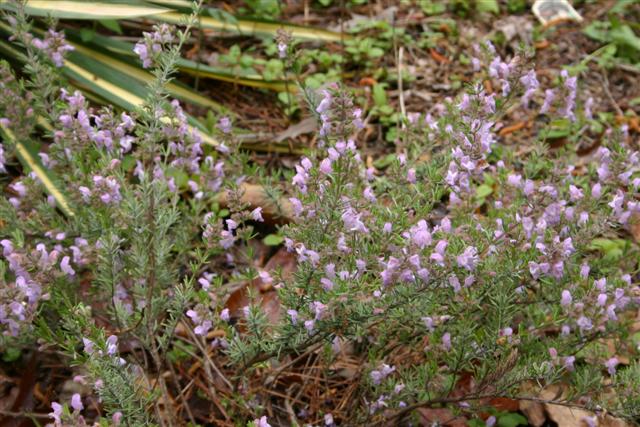
|
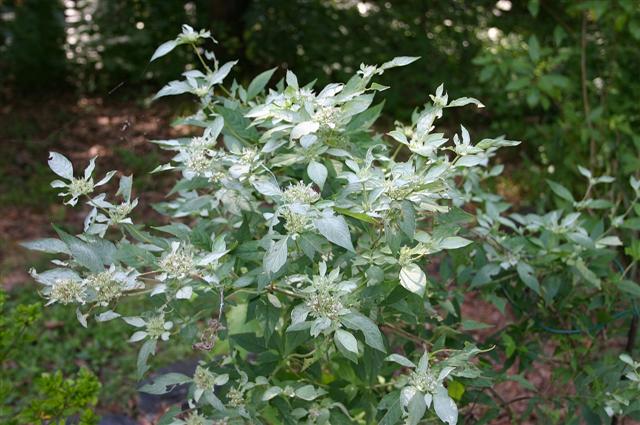
|
| False Rosemary | Mountain Mint |
False rosemary (Conradina canescens) is an evergreen shrub herb native to southern Georgia, Florida and Alabama. Although somewhat
rare in the wild, it has proven to be a very adaptive and ornamental garden plant and hopefully will grow in popularity. In my garden it
has reached a height of about 24 inches tall and wide. From an herbal standpoint, it looks, smells and blooms just like the
common rosemary and can be used for the same culinary purposes. It does require full sun and well-drained soil.
There are several different species collectively known as mountain mint or some variety thereof. All are in
the genus Pycnanthemum and can be found in various abundance in the eastern U.S. I have several that have been
rescued from sites around metro Atlanta. As a "mint," they do spread but not nearly as aggressively as other common
mints. Tolerant of sun and shade, I grow mine in several locations in both my perennial beds and woodland garden. In
late summer, mountain mint will shoot up 3-4 foot stalks of tiny flowers surrounded by dusty silver bracts. I have found
that this mint makes an excellent substitution for culinary mint in the kitchen. I have used it to flavor tea and icecream
as well as dipping the leaves in chocolate. Very tasty.
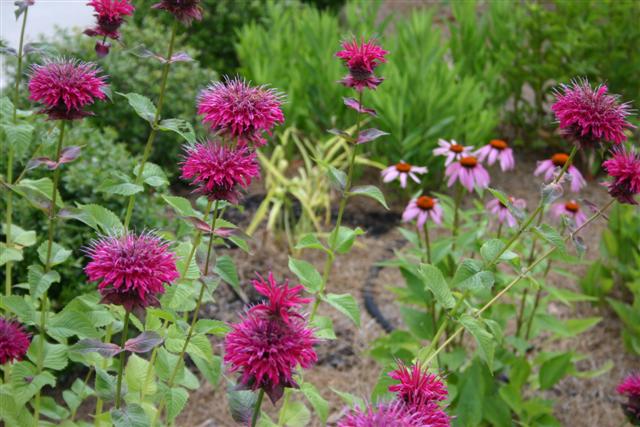
|
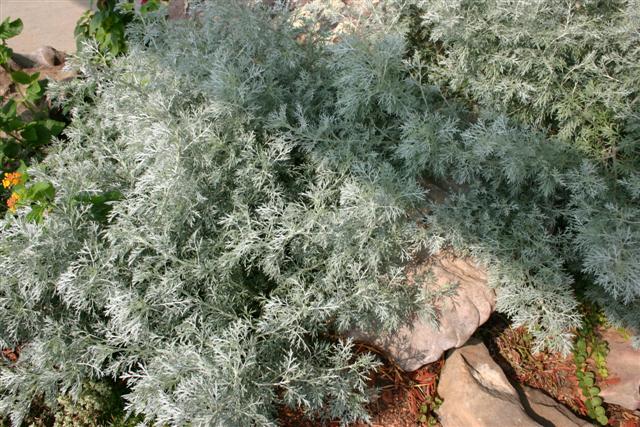
|
| Bee Balm and Purple Coneflower | Wormwood |
Bee balm (Monarda spp.) is another native related to mint and therefore has a tendency to spread. The bright red flowers of my
Jacob Cline Monarda (Monarda didyma 'Jacob Cline') are very attractive to hummingbirds. This mid summer bloomer is very
showy and like the other "mints" has tasty leaves. This variety of Monarda is also known as Oswego Tea as the Oswego Indians
used the plant for a variety of culinary and medicinal purposes. Bee balm can be grown in full sun but in the wild can be
found growing in rich soils in and at the edge of woodland areas.
Purple coneflower (Echinacea) is a prairie native with stalks of showy tall purple daisy-like flowers in summer. Its medicinal
uses are well known and commonly used today. It prefers to grow in open sunny areas with rich well-drained soil. It's hard to
believe that this plant was once considered a weed!
Species of wormwood (Artemisia spp.) are found in all 50 states. They are often noted for their finely dissected
silver foliage. Several species have showy (usually yellow) flowers. The most common garden varieties of wormwood (aka sagebrush,
mugwort, etc.) are species or hybrids of non-natives or natives from the northern and western U.S. Because of this many of these
plants suffer in Georgia from an excess of moisture and never attain the growth seen in drier climates. Note: Some varieties of wormwood
have proven to be invasive. The variegated Oriental Limelight (Artemisia vulgaris 'Janlim') has a reputation for being
a garden thug which I can verify from firsthand experience.
I have only briefly touched upon the topic of using herbs as ornamental garden plants. If you would like more information, you can
visit the web site of the
Herb Society of America.
Resources
There are several books on the topic of using herbs as ornamental plants in the garden. My favorite is:
Herbs in Bloom: A Guide to Growing Herbs as Ornamental Plants
By Jo Ann Gardner, Timber Press Incorporated, 2005
Copyright © 2008 by Theresa Schrum - All rights reserved
No part of this website may be reproduced without the expressed written permission of Theresa Schrum
